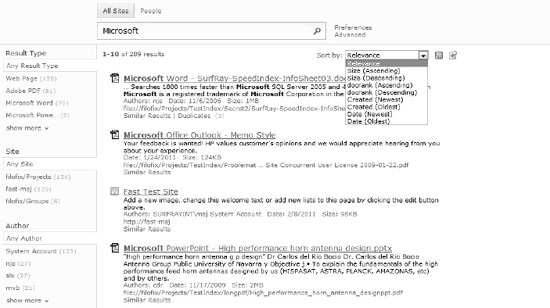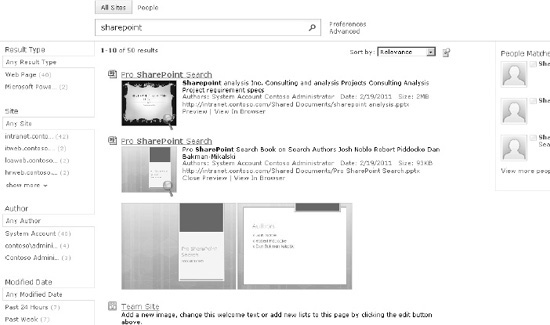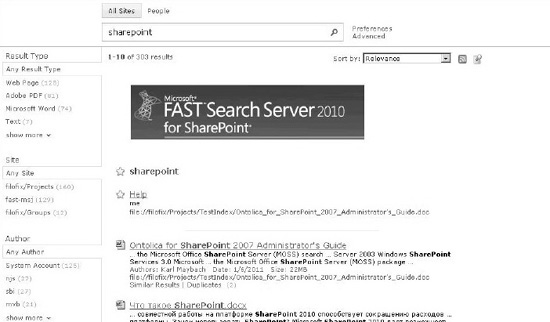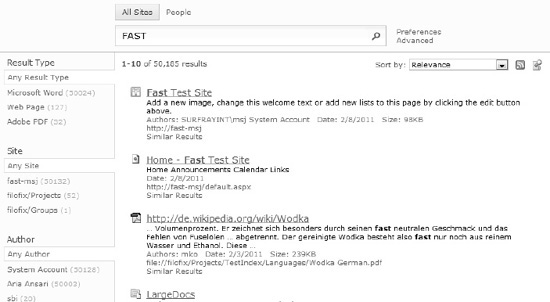3. FAST Search Server 2010 for SharePoint
In Wave 14,
Microsoft has decided to attack alternative enterprise search engines
head-on. In early 2008, Microsoft acquired the Norwegian enterprise
search vendor FAST Search and Transfer (FAST). Established nearly a
decade earlier, FAST was one of the world's leading providers of
high-end search and business intelligence solutions. Its platform, FAST
ESP, is a highly customizable and scalable search engine capable of
meeting a seemingly endless array of search- and intelligence-based
business needs. By acquiring FAST, Microsoft took a significant step
toward alleviating its deficiencies in the search marketplace.
Since the acquisition,
Microsoft and the FAST Group have been hard at work to integrate FAST's
search technologies into Microsoft's more mainstream infrastructure
solutions. While some of these technologies are available in native
SharePoint 2010 Search, the release of FAST Search Server for SharePoint
2010 established Microsoft as a real player in the enterprise search
space. FAST Search Server for SharePoint 2010 is a replacement for the
SharePoint search architecture. It integrates seamlessly into SharePoint
2010 with a familiar interface and by picking up settings, permissions,
and metadata. FAST Search Server for SharePoint 2010 is not an
extension to SharePoint 2010 Search, however; it is a replacement, since
it does require dedicated servers and adds a completely different index
pipeline.
NOTE
FAST Search Server for
SharePoint 2010 should not be confused with its stand-alone enterprise
search platform, FAST ESP. FAST ESP is a service-oriented architecture
used to build search-derived applications.
FAST Search Server for
SharePoint 2010 can greatly expand the user interface and the search
back end for enterprise SharePoint deployments. The platform includes
all of the features of standard SharePoint 2010 Search and adds
additional user interface features such as advanced sorting, document
previews, deep numbered refiners, and visual best bets. Advanced sorting
allows for a broad range of additional search sorting options beyond
SharePoint 2010's standard relevancy. This feature is similar to the
"display relevance view option" and "display modified date view option"
in standard SharePoint 2010, but provides more extensive sorting such as
size, document rank, created date, and modified date. These sorting
options can also be customized to meet the specific needs of a
deployment. Figure 3 shows the default options made available with this feature.

One of the most popular
features of FAST Search Server for SharePoint 2010 is the document
thumbnail and preview feature. FAST
Search Server for SharePoint 2010's document preview is made available
through the use of SharePoint Office Web Applications (OWA), so previews
are available only for Office documents. More specifically, first-page
thumbnails are available on the search results page for Microsoft Word
and PowerPoint files. Full document previews are currently available
only for PowerPoint files (Figure 4).
For FAST's thumbnail and document preview to function, the document
must be stored on a SharePoint 2010 site that has OWA enabled. While
this does provide a nice visualization enhancement for SharePoint,
clients using the search replacement should be aware that previews for
Office files other than Word and PowerPoint are not supported and users
must have OWA enabled on their browsers. This does lead to the
restriction that users cannot preview PDF, Autodesk, or other Microsoft
Office file formats. Caution should also be used when deploying this
feature to public sites or those that are expected to be accessed via
mobile devices, where the installation of OWA cannot be reasonably
assured.

NOTE
Visualization solutions,
such as SurfRay's Ontolica Preview and BA Insight's Longitude Preview,
can be added to FAST to support broader content types.
FAST Search Server for
SharePoint 2010 greatly enhances the Best Bets feature to allow for
multiple visual best bets. Unlike SharePoint 2010 Search, which allowed
for only one best bet per keyword, multiple suggestions can be tied to a
single keyword using FAST. In addition, with FAST, Best Bets can use
HTML for graphical best bets similar to those found on web sites instead
of the simple text suggestions provided with SharePoint. This is
especially beneficial to organizations that wish to use SharePoint 2010
on public-facing deployments. Figure 5
shows the difference between best bets in SharePoint 2010 and those
available in FAST for SharePoint. The visual banner is a FAST best bet,
whereas the second item titled sharepoint with a star is a standard SPS2010 best bet.

The popular search
refinement Web Part is also greatly enhanced in FAST for SharePoint.
Instead of providing plain, shallow refinements that can analyze only
the first 50 items in a result set by default, FAST's refinements are
deep and numbered (Figure 6).
This allows for refiners based on the aggregation of managed properties
for the entire result set. This has the significant benefit of
refinement options reflecting all items matching a query. It does,
however, take a significant amount of memory from the query server for
large result sets, so enabling this feature should be done with caution.
For deployments of FAST for SharePoint with more limited hardware or a
high query frequency, the option remains available to display
refinements based only on the aggregation of properties for the top 100
search results.

FAST Search Server for
SharePoint 2010 can also enhance the user interface by providing
different result relevancy, best bets, and refinement options based on
user context. This allows the search interface to be catered toward user
groups. For example, when searching for the keyword "expansion," people
logged in from the sales group may get a best bet for documents
outlining the strategy to increase sales figures in a new geography.
People in this department may also get search refinements based on
product groups or sales territories. If a user from the human resources
department executes the same query, FAST Search Server for SharePoint
2010 can be configured to provide a different experience for that user
based on his or her department. The user in the human resources
department that searches for the keyword "expansion" could get a visual
best bet for hiring policies in a newly established department. The
search refinements may include fields such as department, clearance
level, or policy type.
All of these user-side features
can be added through significantly less expensive search extensions. The features that make
FAST Search Server for SharePoint 2010 stand out are those on the back
end. FAST Search Server for SharePoint 2010 replaces SharePoint 2010's
search architecture with an extremely scalable search engine. While
SharePoint 2010's native search index can handle up to 100 million
items, FAST Search Server for SharePoint 2010 can be scaled to index
billions of items while retaining sub-second query times. Like the
Google Search Appliance, scalability is dependent on licensing and
hardware. FAST Search Server 2010 for SharePoint requires its own
dedicated hardware. It cannot be installed on the same server as
SharePoint Server 2010. The minimum hardware requirements include a
dedicated server with 4GB RAM, 4 CPU cores, and 50GB of disk space, but
16GB RAM, 8 CPU cores, and 1TB of disk space on RAID are highly
recommended to achieve the intended performance. Due to the enterprise
nature of the search engine, however, most deployments contain about
four servers dedicated to FAST Search Server 2010 for SharePoint.
In addition to an
extremely scalable index, FAST provides much greater control over the
index pipeline. SharePoint 2010 Search was designed to make access to
powerful search relatively simple. As a result, some limitations were
implemented in what can be manipulated in regards to relevancy during
indexing. SharePoint 2010's index pipeline can be considered a black
box, with very little ability for manipulation. SharePoint 2010 and
FAST's default relevancy is designed to provide accurate results on
intranets against large sets of different data. Each organization's
needs are different, and because relevancy is perceived differently
among different users and organizations, it may be helpful to tune
relevancy according to specific needs. Organizations that wish to
directly influence relevancy algorithms can do so using FAST Search
Server for SharePoint 2010. Administrators with programming and Windows
PowerShell experience can blend multiple rank components such as content
context, authority, term proximity, and quality. Keyword-driven,
statistic, dynamic, and linguistic relevance can all be manipulated to
affect the order of items in a result set.
FAST allows
administrators to extract metadata at index time, execute business
intelligence activities on the fly, and build custom queries using
FAST's proprietary FQL query language. FAST's metadata extraction is
similar to the auto-classification solutions , although it does require a bit more manual attention. Metadata
can be extracted from the plain text within items as they are indexed,
even if no formal structure exists within the file. This allows for
significantly improved connection of structured concepts and properties
to documents. This metadata can then be used to enhance search relevancy
and provide more accurate refinement options to users.
Finally, much of the
real potential for large enterprises that choose to implement FAST
Search Server for SharePoint 2010 is tied to the ability to use it for a
core to custom search-based application (SBA) development. Microsoft
has taken the first step to pulling search technologies out of the
search center and into other applications. For example, FAST can be
connected to business intelligence solutions such as Excel workbooks and
Reporting Services reports. This allows for advanced discovery of
statistical information that may be useful for management teams to
understand how employees are working and utilizing data. It also
provides the ability for marketing teams to use search to understand how
clients may be navigating a public SharePoint site or what best bets
are most effective in converting site browsers to clients. Developers
and consultants can utilize the FAST Search Server for SharePoint 2010
as the core infrastructure for advanced systems or portals that rely on
information access and reporting. Examples include search-based
applications such as research and development portals, product support
dashboards, supply chain management trackers, and compliance tools.
As mentioned earlier,
FAST Search Server for SharePoint 2010 is licensed separately from
SharePoint 2010. Unlike the Google Search Appliance, which includes
everything needed in one package, organizations that wish to implement
FAST must purchase hardware, Windows Server, SQL, and FAST Search Server
licensing. Users must have the enterprise client access license (ECAL)
to access the FAST features. At the end of 2010, pricing per server for
FAST Search Server 2010 for SharePoint started at about US$22,000.
4. Choosing the Best Option
This section was meant to
provide only a high-level overview of the most popular options for
replacing SharePoint 2010's native search engine. Considering the financial and
time investments required to implement enterprise search engines, even
those that are marketed to be simple, a thorough analysis of the best
solution to meet an organization's particular needs should be conducted.
A hasty jump into a mixed platform may prove to be a costly waste of
resources if better hardware or user interface extensions would meet
needs with greater efficiency. Table 1 will assist with an initial analysis of options.
Table 1. SharePoint 2010, GSA, and FAST Comparison
| Feature | SharePoint 2010 | Google Search Appliance | FAST Search Server 2010 for SharePoint |
|---|
| Front end | | | |
| Basic search | X | X | X |
| Scopes | X | | X |
| Search enhancements based on user context | | X | X |
| Custom properties | X | | X |
| Property extraction | Limited | | X |
| Query suggestions | X | X | X |
| Search as you type | | X | |
| Similar results | | | X |
| Visual Best Bets | | X | X |
| Sort results on managed properties or rank profiles | | | X |
| Shallow results refinement | X | X | X |
| Deep results refinement | | | X |
| Result clustering | | X | X |
| Document Previewers | | | X |
| Alerts | X | x | X |
| Query federation | X | X | X |
| Windows 7 federation | X | X | X |
| People search | X | X | X |
| Social search | X | X | X |
| Back end | | | |
| Taxonomy integration | X | | X |
| *Multi-tenant hosting | X | X | |
| Rich web indexing support | | X | X |
| Support for MySites, profiles pages, social tagging, and other social computing features | X | X | X |
| Automatic relevancy tuning by document or site promotions | Limited | X | X |
| Manually tunable relevance with multiple rank profiles | | X | X |
| Language support for most Latin-based languages | X | X | X |
| Language support for Asian characters | | X | |
| Real-time language translation for queries and results | | X | |
| Metadata extraction during indexing | | | X |
| Integration of advanced BI tasks | | X | X |
| Access to line-of-business (LOB) data systems | X | X | X |
| Site map auto-generation for global search engines | | X | |
| Topology scalability | Multiple servers | Multiple servers | Multiple servers |
| Maximum index capacity | Approx. 100 million items | Billions | Billions |
NOTE
One especially
important item to note from the previous table is that unlike standard
SharePoint 2010 and GSA, FAST Search Server for SharePoint is not
capable multi-tenant hosting. FAST Search Server must be deployed on a
farm dedicated to a single SharePoint customer and cannot be offered
through hosting providers as a shared service.